Experiment Report: Fly Ash as a Sustainable Cement Replacement
VerifiedAdded on 2023/06/11
|23
|5721
|291
Report
AI Summary
This report investigates the potential of fly ash as a partial or complete replacement for Portland cement in concrete production, addressing the environmental concerns associated with cement manufacturing due to its significant CO2 emissions. The study examines the properties of fly ash, a byproduct of coal combustion, highlighting its pozzolanic nature and its ability to react with calcium hydroxide to form hydrated calcium silicate, enhancing concrete strength. The report details the benefits of fly ash, including reduced water requirements, improved work efficiency, increased durability, and resistance to chemical reactions. It also discusses the different classes of fly ash (Class C and Class F) and their respective characteristics, emphasizing the importance of selecting the appropriate type based on specific project requirements. While acknowledging the advantages of fly ash, the report also addresses potential drawbacks such as slower setting times and the need for careful consideration of environmental and technical factors when determining optimal usage levels. Desklib provides a platform for students to access similar solved assignments and study resources.
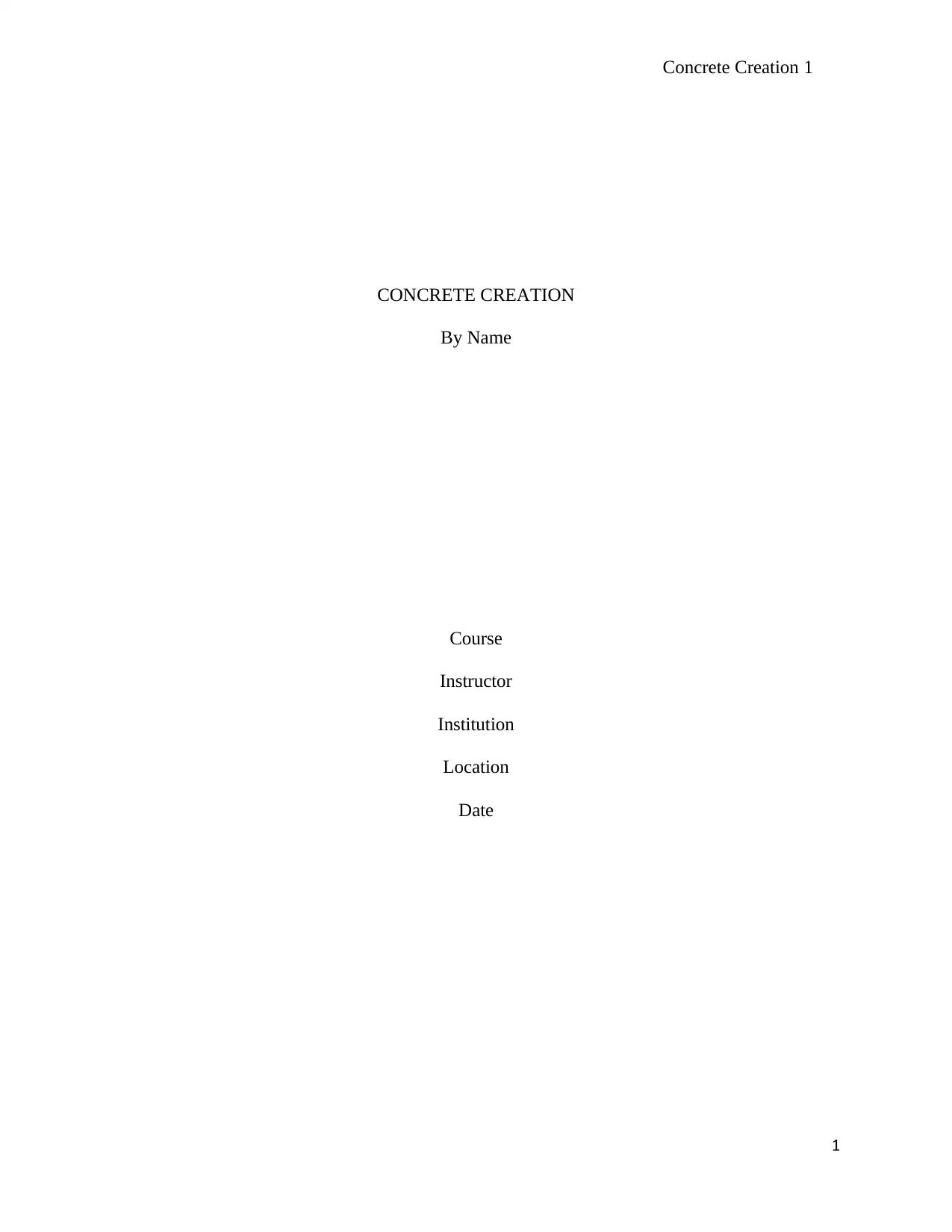
Concrete Creation 1
CONCRETE CREATION
By Name
Course
Instructor
Institution
Location
Date
1
CONCRETE CREATION
By Name
Course
Instructor
Institution
Location
Date
1
Paraphrase This Document
Need a fresh take? Get an instant paraphrase of this document with our AI Paraphraser
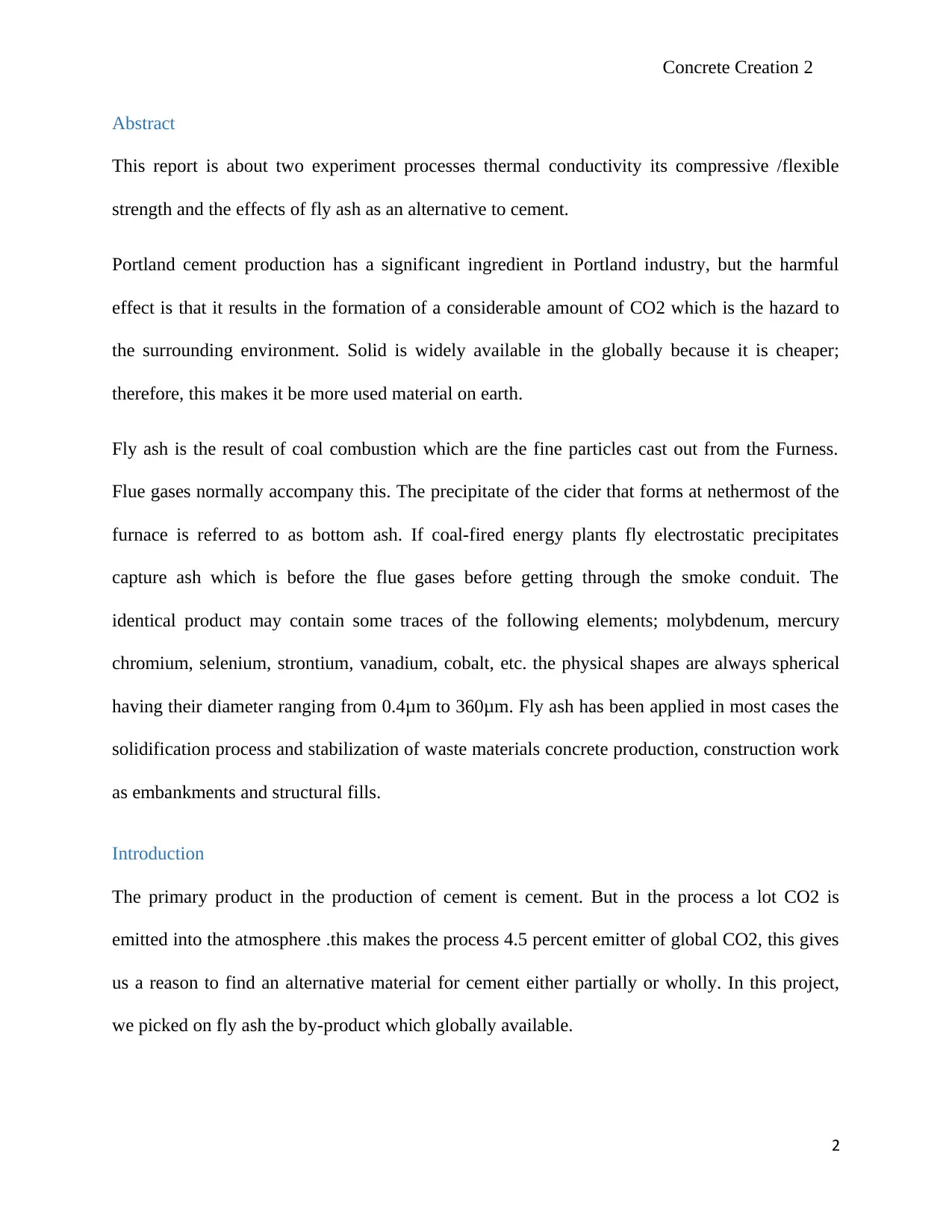
Concrete Creation 2
Abstract
This report is about two experiment processes thermal conductivity its compressive /flexible
strength and the effects of fly ash as an alternative to cement.
Portland cement production has a significant ingredient in Portland industry, but the harmful
effect is that it results in the formation of a considerable amount of CO2 which is the hazard to
the surrounding environment. Solid is widely available in the globally because it is cheaper;
therefore, this makes it be more used material on earth.
Fly ash is the result of coal combustion which are the fine particles cast out from the Furness.
Flue gases normally accompany this. The precipitate of the cider that forms at nethermost of the
furnace is referred to as bottom ash. If coal-fired energy plants fly electrostatic precipitates
capture ash which is before the flue gases before getting through the smoke conduit. The
identical product may contain some traces of the following elements; molybdenum, mercury
chromium, selenium, strontium, vanadium, cobalt, etc. the physical shapes are always spherical
having their diameter ranging from 0.4μm to 360μm. Fly ash has been applied in most cases the
solidification process and stabilization of waste materials concrete production, construction work
as embankments and structural fills.
Introduction
The primary product in the production of cement is cement. But in the process a lot CO2 is
emitted into the atmosphere .this makes the process 4.5 percent emitter of global CO2, this gives
us a reason to find an alternative material for cement either partially or wholly. In this project,
we picked on fly ash the by-product which globally available.
2
Abstract
This report is about two experiment processes thermal conductivity its compressive /flexible
strength and the effects of fly ash as an alternative to cement.
Portland cement production has a significant ingredient in Portland industry, but the harmful
effect is that it results in the formation of a considerable amount of CO2 which is the hazard to
the surrounding environment. Solid is widely available in the globally because it is cheaper;
therefore, this makes it be more used material on earth.
Fly ash is the result of coal combustion which are the fine particles cast out from the Furness.
Flue gases normally accompany this. The precipitate of the cider that forms at nethermost of the
furnace is referred to as bottom ash. If coal-fired energy plants fly electrostatic precipitates
capture ash which is before the flue gases before getting through the smoke conduit. The
identical product may contain some traces of the following elements; molybdenum, mercury
chromium, selenium, strontium, vanadium, cobalt, etc. the physical shapes are always spherical
having their diameter ranging from 0.4μm to 360μm. Fly ash has been applied in most cases the
solidification process and stabilization of waste materials concrete production, construction work
as embankments and structural fills.
Introduction
The primary product in the production of cement is cement. But in the process a lot CO2 is
emitted into the atmosphere .this makes the process 4.5 percent emitter of global CO2, this gives
us a reason to find an alternative material for cement either partially or wholly. In this project,
we picked on fly ash the by-product which globally available.
2
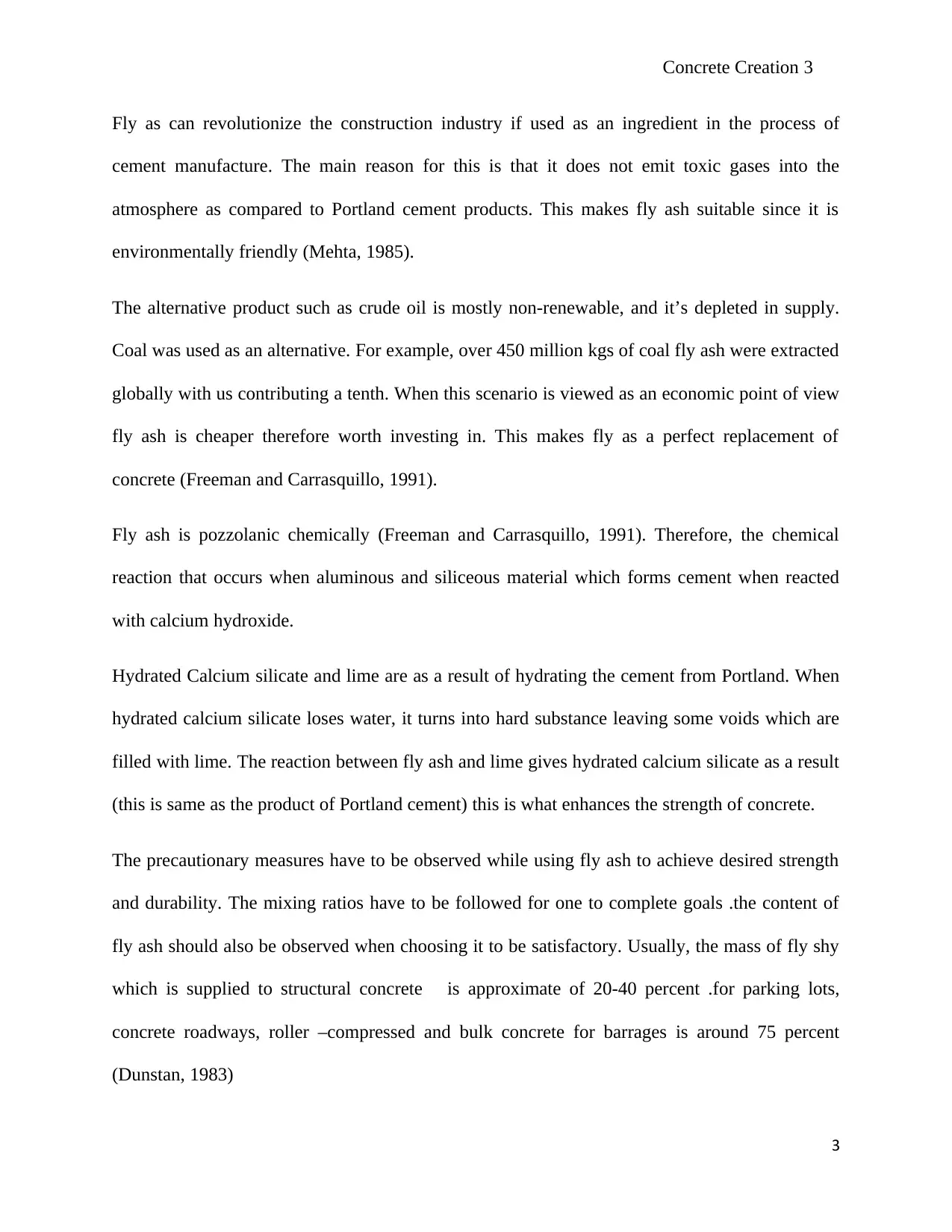
Concrete Creation 3
Fly as can revolutionize the construction industry if used as an ingredient in the process of
cement manufacture. The main reason for this is that it does not emit toxic gases into the
atmosphere as compared to Portland cement products. This makes fly ash suitable since it is
environmentally friendly (Mehta, 1985).
The alternative product such as crude oil is mostly non-renewable, and it’s depleted in supply.
Coal was used as an alternative. For example, over 450 million kgs of coal fly ash were extracted
globally with us contributing a tenth. When this scenario is viewed as an economic point of view
fly ash is cheaper therefore worth investing in. This makes fly as a perfect replacement of
concrete (Freeman and Carrasquillo, 1991).
Fly ash is pozzolanic chemically (Freeman and Carrasquillo, 1991). Therefore, the chemical
reaction that occurs when aluminous and siliceous material which forms cement when reacted
with calcium hydroxide.
Hydrated Calcium silicate and lime are as a result of hydrating the cement from Portland. When
hydrated calcium silicate loses water, it turns into hard substance leaving some voids which are
filled with lime. The reaction between fly ash and lime gives hydrated calcium silicate as a result
(this is same as the product of Portland cement) this is what enhances the strength of concrete.
The precautionary measures have to be observed while using fly ash to achieve desired strength
and durability. The mixing ratios have to be followed for one to complete goals .the content of
fly ash should also be observed when choosing it to be satisfactory. Usually, the mass of fly shy
which is supplied to structural concrete is approximate of 20-40 percent .for parking lots,
concrete roadways, roller –compressed and bulk concrete for barrages is around 75 percent
(Dunstan, 1983)
3
Fly as can revolutionize the construction industry if used as an ingredient in the process of
cement manufacture. The main reason for this is that it does not emit toxic gases into the
atmosphere as compared to Portland cement products. This makes fly ash suitable since it is
environmentally friendly (Mehta, 1985).
The alternative product such as crude oil is mostly non-renewable, and it’s depleted in supply.
Coal was used as an alternative. For example, over 450 million kgs of coal fly ash were extracted
globally with us contributing a tenth. When this scenario is viewed as an economic point of view
fly ash is cheaper therefore worth investing in. This makes fly as a perfect replacement of
concrete (Freeman and Carrasquillo, 1991).
Fly ash is pozzolanic chemically (Freeman and Carrasquillo, 1991). Therefore, the chemical
reaction that occurs when aluminous and siliceous material which forms cement when reacted
with calcium hydroxide.
Hydrated Calcium silicate and lime are as a result of hydrating the cement from Portland. When
hydrated calcium silicate loses water, it turns into hard substance leaving some voids which are
filled with lime. The reaction between fly ash and lime gives hydrated calcium silicate as a result
(this is same as the product of Portland cement) this is what enhances the strength of concrete.
The precautionary measures have to be observed while using fly ash to achieve desired strength
and durability. The mixing ratios have to be followed for one to complete goals .the content of
fly ash should also be observed when choosing it to be satisfactory. Usually, the mass of fly shy
which is supplied to structural concrete is approximate of 20-40 percent .for parking lots,
concrete roadways, roller –compressed and bulk concrete for barrages is around 75 percent
(Dunstan, 1983)
3
⊘ This is a preview!⊘
Do you want full access?
Subscribe today to unlock all pages.

Trusted by 1+ million students worldwide
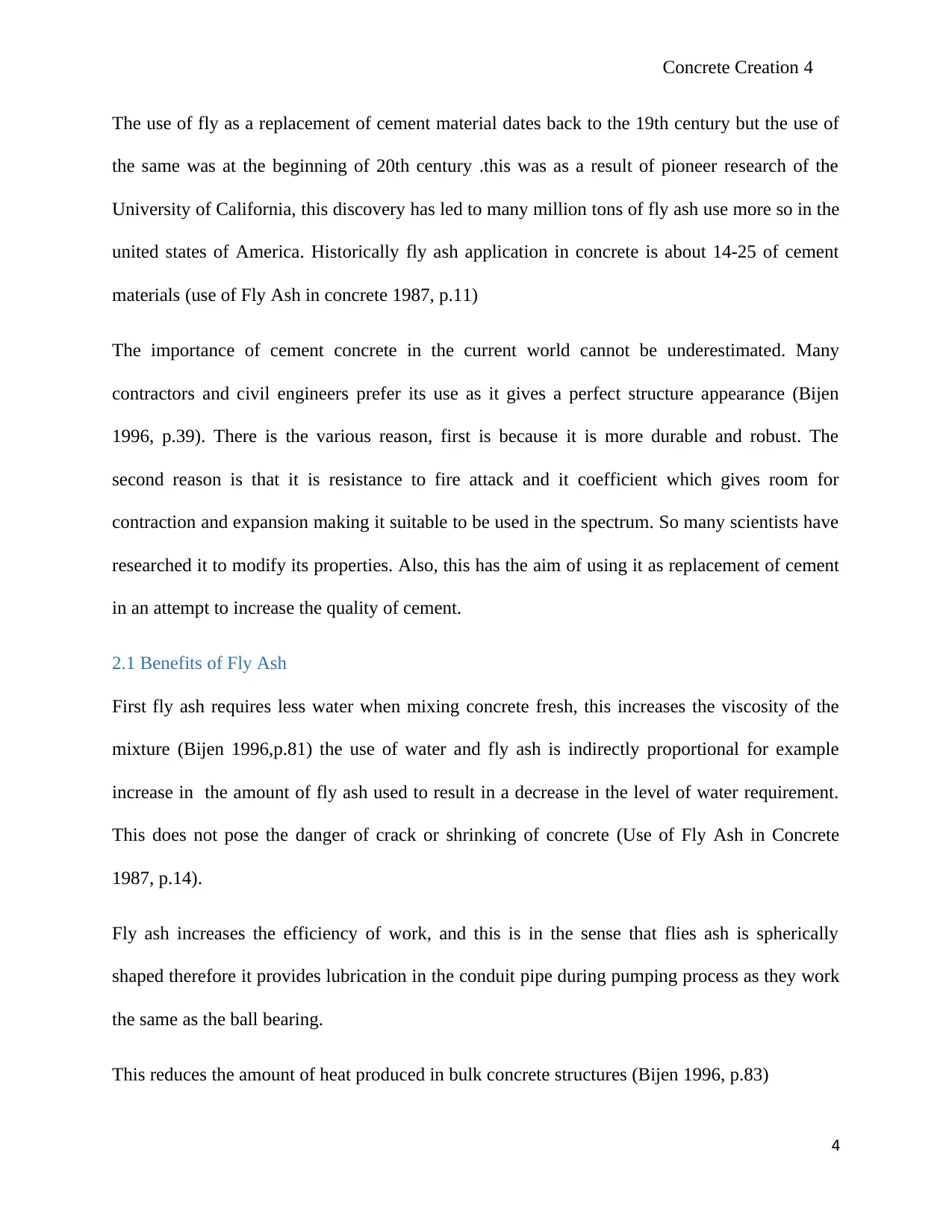
Concrete Creation 4
The use of fly as a replacement of cement material dates back to the 19th century but the use of
the same was at the beginning of 20th century .this was as a result of pioneer research of the
University of California, this discovery has led to many million tons of fly ash use more so in the
united states of America. Historically fly ash application in concrete is about 14-25 of cement
materials (use of Fly Ash in concrete 1987, p.11)
The importance of cement concrete in the current world cannot be underestimated. Many
contractors and civil engineers prefer its use as it gives a perfect structure appearance (Bijen
1996, p.39). There is the various reason, first is because it is more durable and robust. The
second reason is that it is resistance to fire attack and it coefficient which gives room for
contraction and expansion making it suitable to be used in the spectrum. So many scientists have
researched it to modify its properties. Also, this has the aim of using it as replacement of cement
in an attempt to increase the quality of cement.
2.1 Benefits of Fly Ash
First fly ash requires less water when mixing concrete fresh, this increases the viscosity of the
mixture (Bijen 1996,p.81) the use of water and fly ash is indirectly proportional for example
increase in the amount of fly ash used to result in a decrease in the level of water requirement.
This does not pose the danger of crack or shrinking of concrete (Use of Fly Ash in Concrete
1987, p.14).
Fly ash increases the efficiency of work, and this is in the sense that flies ash is spherically
shaped therefore it provides lubrication in the conduit pipe during pumping process as they work
the same as the ball bearing.
This reduces the amount of heat produced in bulk concrete structures (Bijen 1996, p.83)
4
The use of fly as a replacement of cement material dates back to the 19th century but the use of
the same was at the beginning of 20th century .this was as a result of pioneer research of the
University of California, this discovery has led to many million tons of fly ash use more so in the
united states of America. Historically fly ash application in concrete is about 14-25 of cement
materials (use of Fly Ash in concrete 1987, p.11)
The importance of cement concrete in the current world cannot be underestimated. Many
contractors and civil engineers prefer its use as it gives a perfect structure appearance (Bijen
1996, p.39). There is the various reason, first is because it is more durable and robust. The
second reason is that it is resistance to fire attack and it coefficient which gives room for
contraction and expansion making it suitable to be used in the spectrum. So many scientists have
researched it to modify its properties. Also, this has the aim of using it as replacement of cement
in an attempt to increase the quality of cement.
2.1 Benefits of Fly Ash
First fly ash requires less water when mixing concrete fresh, this increases the viscosity of the
mixture (Bijen 1996,p.81) the use of water and fly ash is indirectly proportional for example
increase in the amount of fly ash used to result in a decrease in the level of water requirement.
This does not pose the danger of crack or shrinking of concrete (Use of Fly Ash in Concrete
1987, p.14).
Fly ash increases the efficiency of work, and this is in the sense that flies ash is spherically
shaped therefore it provides lubrication in the conduit pipe during pumping process as they work
the same as the ball bearing.
This reduces the amount of heat produced in bulk concrete structures (Bijen 1996, p.83)
4
Paraphrase This Document
Need a fresh take? Get an instant paraphrase of this document with our AI Paraphraser
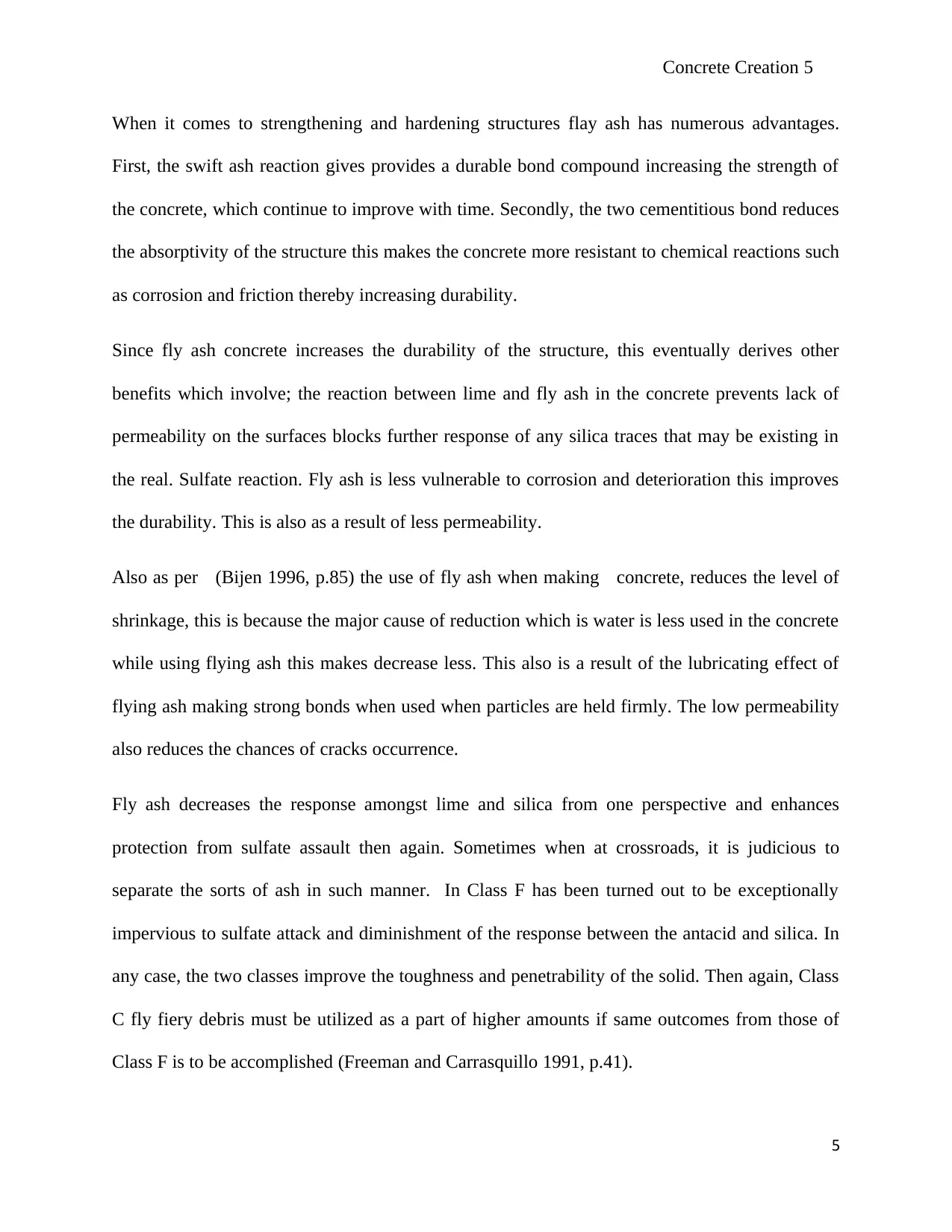
Concrete Creation 5
When it comes to strengthening and hardening structures flay ash has numerous advantages.
First, the swift ash reaction gives provides a durable bond compound increasing the strength of
the concrete, which continue to improve with time. Secondly, the two cementitious bond reduces
the absorptivity of the structure this makes the concrete more resistant to chemical reactions such
as corrosion and friction thereby increasing durability.
Since fly ash concrete increases the durability of the structure, this eventually derives other
benefits which involve; the reaction between lime and fly ash in the concrete prevents lack of
permeability on the surfaces blocks further response of any silica traces that may be existing in
the real. Sulfate reaction. Fly ash is less vulnerable to corrosion and deterioration this improves
the durability. This is also as a result of less permeability.
Also as per (Bijen 1996, p.85) the use of fly ash when making concrete, reduces the level of
shrinkage, this is because the major cause of reduction which is water is less used in the concrete
while using flying ash this makes decrease less. This also is a result of the lubricating effect of
flying ash making strong bonds when used when particles are held firmly. The low permeability
also reduces the chances of cracks occurrence.
Fly ash decreases the response amongst lime and silica from one perspective and enhances
protection from sulfate assault then again. Sometimes when at crossroads, it is judicious to
separate the sorts of ash in such manner. In Class F has been turned out to be exceptionally
impervious to sulfate attack and diminishment of the response between the antacid and silica. In
any case, the two classes improve the toughness and penetrability of the solid. Then again, Class
C fly fiery debris must be utilized as a part of higher amounts if same outcomes from those of
Class F is to be accomplished (Freeman and Carrasquillo 1991, p.41).
5
When it comes to strengthening and hardening structures flay ash has numerous advantages.
First, the swift ash reaction gives provides a durable bond compound increasing the strength of
the concrete, which continue to improve with time. Secondly, the two cementitious bond reduces
the absorptivity of the structure this makes the concrete more resistant to chemical reactions such
as corrosion and friction thereby increasing durability.
Since fly ash concrete increases the durability of the structure, this eventually derives other
benefits which involve; the reaction between lime and fly ash in the concrete prevents lack of
permeability on the surfaces blocks further response of any silica traces that may be existing in
the real. Sulfate reaction. Fly ash is less vulnerable to corrosion and deterioration this improves
the durability. This is also as a result of less permeability.
Also as per (Bijen 1996, p.85) the use of fly ash when making concrete, reduces the level of
shrinkage, this is because the major cause of reduction which is water is less used in the concrete
while using flying ash this makes decrease less. This also is a result of the lubricating effect of
flying ash making strong bonds when used when particles are held firmly. The low permeability
also reduces the chances of cracks occurrence.
Fly ash decreases the response amongst lime and silica from one perspective and enhances
protection from sulfate assault then again. Sometimes when at crossroads, it is judicious to
separate the sorts of ash in such manner. In Class F has been turned out to be exceptionally
impervious to sulfate attack and diminishment of the response between the antacid and silica. In
any case, the two classes improve the toughness and penetrability of the solid. Then again, Class
C fly fiery debris must be utilized as a part of higher amounts if same outcomes from those of
Class F is to be accomplished (Freeman and Carrasquillo 1991, p.41).
5
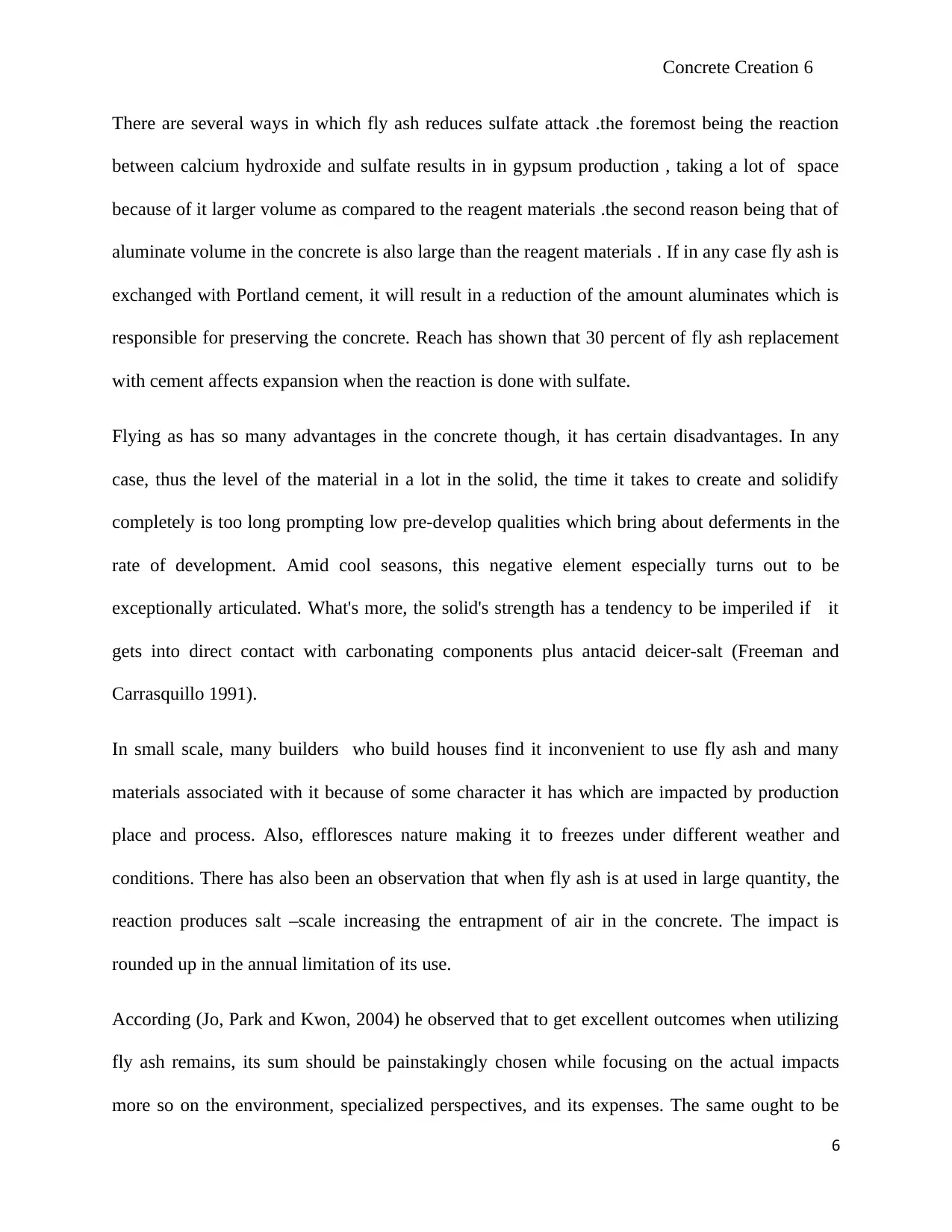
Concrete Creation 6
There are several ways in which fly ash reduces sulfate attack .the foremost being the reaction
between calcium hydroxide and sulfate results in in gypsum production , taking a lot of space
because of it larger volume as compared to the reagent materials .the second reason being that of
aluminate volume in the concrete is also large than the reagent materials . If in any case fly ash is
exchanged with Portland cement, it will result in a reduction of the amount aluminates which is
responsible for preserving the concrete. Reach has shown that 30 percent of fly ash replacement
with cement affects expansion when the reaction is done with sulfate.
Flying as has so many advantages in the concrete though, it has certain disadvantages. In any
case, thus the level of the material in a lot in the solid, the time it takes to create and solidify
completely is too long prompting low pre-develop qualities which bring about deferments in the
rate of development. Amid cool seasons, this negative element especially turns out to be
exceptionally articulated. What's more, the solid's strength has a tendency to be imperiled if it
gets into direct contact with carbonating components plus antacid deicer-salt (Freeman and
Carrasquillo 1991).
In small scale, many builders who build houses find it inconvenient to use fly ash and many
materials associated with it because of some character it has which are impacted by production
place and process. Also, effloresces nature making it to freezes under different weather and
conditions. There has also been an observation that when fly ash is at used in large quantity, the
reaction produces salt –scale increasing the entrapment of air in the concrete. The impact is
rounded up in the annual limitation of its use.
According (Jo, Park and Kwon, 2004) he observed that to get excellent outcomes when utilizing
fly ash remains, its sum should be painstakingly chosen while focusing on the actual impacts
more so on the environment, specialized perspectives, and its expenses. The same ought to be
6
There are several ways in which fly ash reduces sulfate attack .the foremost being the reaction
between calcium hydroxide and sulfate results in in gypsum production , taking a lot of space
because of it larger volume as compared to the reagent materials .the second reason being that of
aluminate volume in the concrete is also large than the reagent materials . If in any case fly ash is
exchanged with Portland cement, it will result in a reduction of the amount aluminates which is
responsible for preserving the concrete. Reach has shown that 30 percent of fly ash replacement
with cement affects expansion when the reaction is done with sulfate.
Flying as has so many advantages in the concrete though, it has certain disadvantages. In any
case, thus the level of the material in a lot in the solid, the time it takes to create and solidify
completely is too long prompting low pre-develop qualities which bring about deferments in the
rate of development. Amid cool seasons, this negative element especially turns out to be
exceptionally articulated. What's more, the solid's strength has a tendency to be imperiled if it
gets into direct contact with carbonating components plus antacid deicer-salt (Freeman and
Carrasquillo 1991).
In small scale, many builders who build houses find it inconvenient to use fly ash and many
materials associated with it because of some character it has which are impacted by production
place and process. Also, effloresces nature making it to freezes under different weather and
conditions. There has also been an observation that when fly ash is at used in large quantity, the
reaction produces salt –scale increasing the entrapment of air in the concrete. The impact is
rounded up in the annual limitation of its use.
According (Jo, Park and Kwon, 2004) he observed that to get excellent outcomes when utilizing
fly ash remains, its sum should be painstakingly chosen while focusing on the actual impacts
more so on the environment, specialized perspectives, and its expenses. The same ought to be
6
⊘ This is a preview!⊘
Do you want full access?
Subscribe today to unlock all pages.

Trusted by 1+ million students worldwide
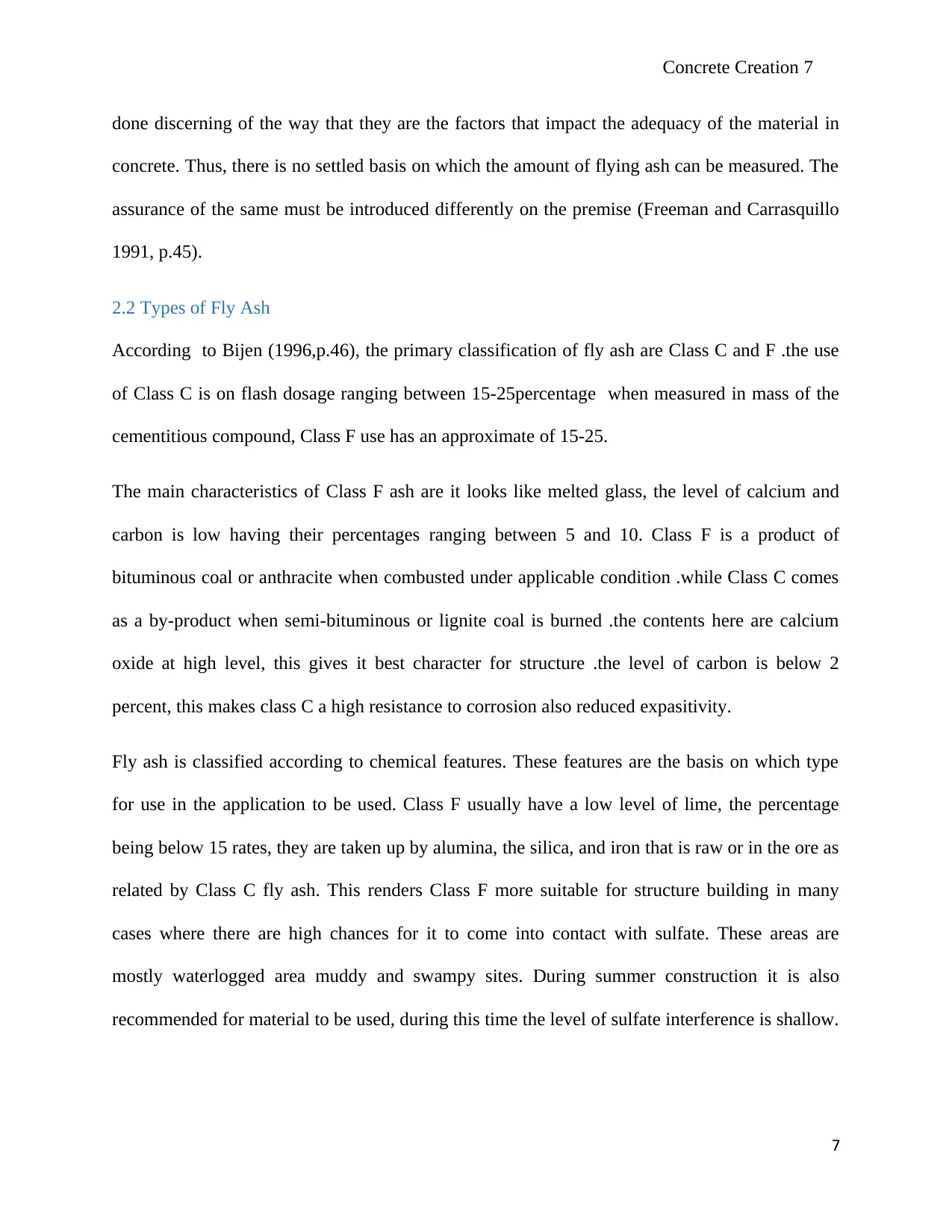
Concrete Creation 7
done discerning of the way that they are the factors that impact the adequacy of the material in
concrete. Thus, there is no settled basis on which the amount of flying ash can be measured. The
assurance of the same must be introduced differently on the premise (Freeman and Carrasquillo
1991, p.45).
2.2 Types of Fly Ash
According to Bijen (1996,p.46), the primary classification of fly ash are Class C and F .the use
of Class C is on flash dosage ranging between 15-25percentage when measured in mass of the
cementitious compound, Class F use has an approximate of 15-25.
The main characteristics of Class F ash are it looks like melted glass, the level of calcium and
carbon is low having their percentages ranging between 5 and 10. Class F is a product of
bituminous coal or anthracite when combusted under applicable condition .while Class C comes
as a by-product when semi-bituminous or lignite coal is burned .the contents here are calcium
oxide at high level, this gives it best character for structure .the level of carbon is below 2
percent, this makes class C a high resistance to corrosion also reduced expasitivity.
Fly ash is classified according to chemical features. These features are the basis on which type
for use in the application to be used. Class F usually have a low level of lime, the percentage
being below 15 rates, they are taken up by alumina, the silica, and iron that is raw or in the ore as
related by Class C fly ash. This renders Class F more suitable for structure building in many
cases where there are high chances for it to come into contact with sulfate. These areas are
mostly waterlogged area muddy and swampy sites. During summer construction it is also
recommended for material to be used, during this time the level of sulfate interference is shallow.
7
done discerning of the way that they are the factors that impact the adequacy of the material in
concrete. Thus, there is no settled basis on which the amount of flying ash can be measured. The
assurance of the same must be introduced differently on the premise (Freeman and Carrasquillo
1991, p.45).
2.2 Types of Fly Ash
According to Bijen (1996,p.46), the primary classification of fly ash are Class C and F .the use
of Class C is on flash dosage ranging between 15-25percentage when measured in mass of the
cementitious compound, Class F use has an approximate of 15-25.
The main characteristics of Class F ash are it looks like melted glass, the level of calcium and
carbon is low having their percentages ranging between 5 and 10. Class F is a product of
bituminous coal or anthracite when combusted under applicable condition .while Class C comes
as a by-product when semi-bituminous or lignite coal is burned .the contents here are calcium
oxide at high level, this gives it best character for structure .the level of carbon is below 2
percent, this makes class C a high resistance to corrosion also reduced expasitivity.
Fly ash is classified according to chemical features. These features are the basis on which type
for use in the application to be used. Class F usually have a low level of lime, the percentage
being below 15 rates, they are taken up by alumina, the silica, and iron that is raw or in the ore as
related by Class C fly ash. This renders Class F more suitable for structure building in many
cases where there are high chances for it to come into contact with sulfate. These areas are
mostly waterlogged area muddy and swampy sites. During summer construction it is also
recommended for material to be used, during this time the level of sulfate interference is shallow.
7
Paraphrase This Document
Need a fresh take? Get an instant paraphrase of this document with our AI Paraphraser
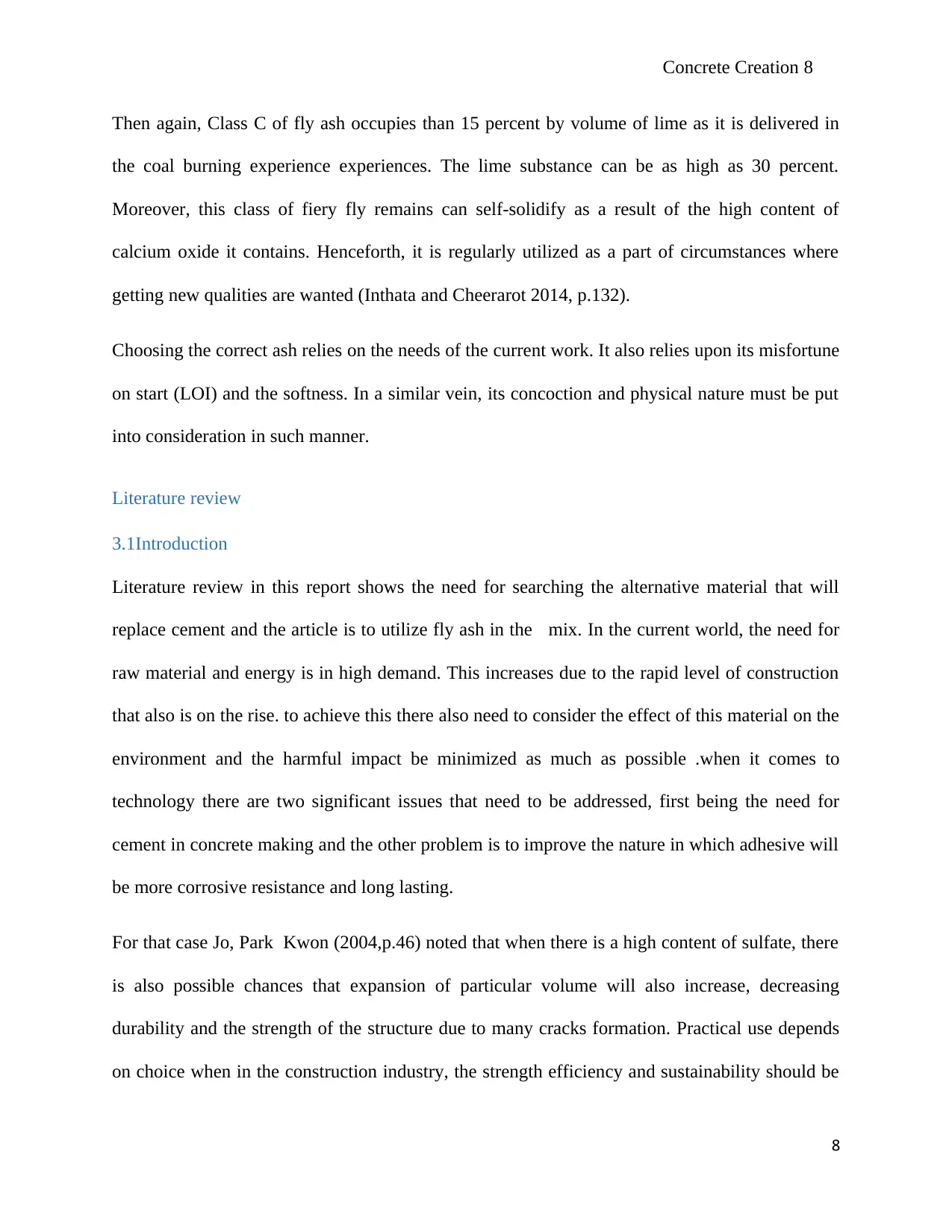
Concrete Creation 8
Then again, Class C of fly ash occupies than 15 percent by volume of lime as it is delivered in
the coal burning experience experiences. The lime substance can be as high as 30 percent.
Moreover, this class of fiery fly remains can self-solidify as a result of the high content of
calcium oxide it contains. Henceforth, it is regularly utilized as a part of circumstances where
getting new qualities are wanted (Inthata and Cheerarot 2014, p.132).
Choosing the correct ash relies on the needs of the current work. It also relies upon its misfortune
on start (LOI) and the softness. In a similar vein, its concoction and physical nature must be put
into consideration in such manner.
Literature review
3.1Introduction
Literature review in this report shows the need for searching the alternative material that will
replace cement and the article is to utilize fly ash in the mix. In the current world, the need for
raw material and energy is in high demand. This increases due to the rapid level of construction
that also is on the rise. to achieve this there also need to consider the effect of this material on the
environment and the harmful impact be minimized as much as possible .when it comes to
technology there are two significant issues that need to be addressed, first being the need for
cement in concrete making and the other problem is to improve the nature in which adhesive will
be more corrosive resistance and long lasting.
For that case Jo, Park Kwon (2004,p.46) noted that when there is a high content of sulfate, there
is also possible chances that expansion of particular volume will also increase, decreasing
durability and the strength of the structure due to many cracks formation. Practical use depends
on choice when in the construction industry, the strength efficiency and sustainability should be
8
Then again, Class C of fly ash occupies than 15 percent by volume of lime as it is delivered in
the coal burning experience experiences. The lime substance can be as high as 30 percent.
Moreover, this class of fiery fly remains can self-solidify as a result of the high content of
calcium oxide it contains. Henceforth, it is regularly utilized as a part of circumstances where
getting new qualities are wanted (Inthata and Cheerarot 2014, p.132).
Choosing the correct ash relies on the needs of the current work. It also relies upon its misfortune
on start (LOI) and the softness. In a similar vein, its concoction and physical nature must be put
into consideration in such manner.
Literature review
3.1Introduction
Literature review in this report shows the need for searching the alternative material that will
replace cement and the article is to utilize fly ash in the mix. In the current world, the need for
raw material and energy is in high demand. This increases due to the rapid level of construction
that also is on the rise. to achieve this there also need to consider the effect of this material on the
environment and the harmful impact be minimized as much as possible .when it comes to
technology there are two significant issues that need to be addressed, first being the need for
cement in concrete making and the other problem is to improve the nature in which adhesive will
be more corrosive resistance and long lasting.
For that case Jo, Park Kwon (2004,p.46) noted that when there is a high content of sulfate, there
is also possible chances that expansion of particular volume will also increase, decreasing
durability and the strength of the structure due to many cracks formation. Practical use depends
on choice when in the construction industry, the strength efficiency and sustainability should be
8
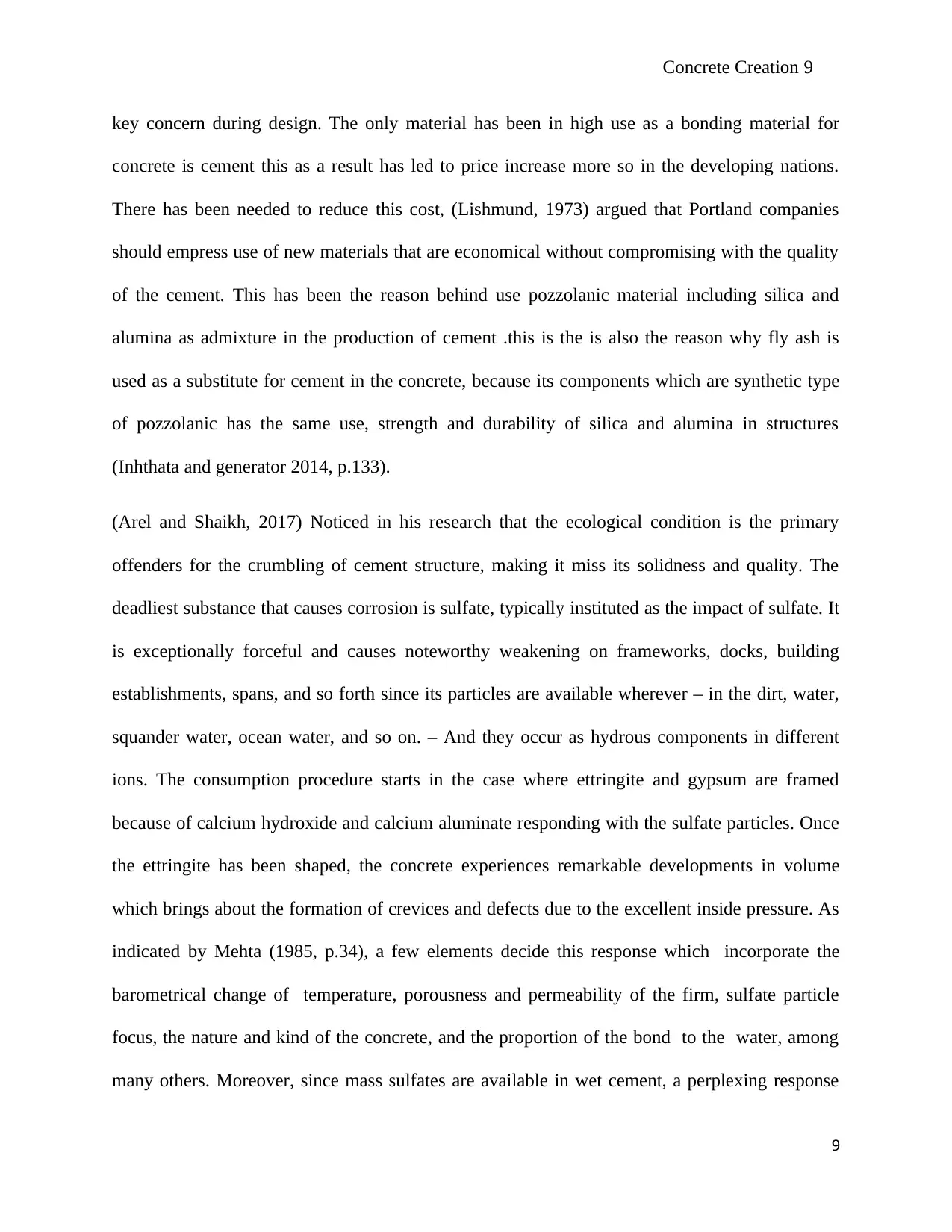
Concrete Creation 9
key concern during design. The only material has been in high use as a bonding material for
concrete is cement this as a result has led to price increase more so in the developing nations.
There has been needed to reduce this cost, (Lishmund, 1973) argued that Portland companies
should empress use of new materials that are economical without compromising with the quality
of the cement. This has been the reason behind use pozzolanic material including silica and
alumina as admixture in the production of cement .this is the is also the reason why fly ash is
used as a substitute for cement in the concrete, because its components which are synthetic type
of pozzolanic has the same use, strength and durability of silica and alumina in structures
(Inhthata and generator 2014, p.133).
(Arel and Shaikh, 2017) Noticed in his research that the ecological condition is the primary
offenders for the crumbling of cement structure, making it miss its solidness and quality. The
deadliest substance that causes corrosion is sulfate, typically instituted as the impact of sulfate. It
is exceptionally forceful and causes noteworthy weakening on frameworks, docks, building
establishments, spans, and so forth since its particles are available wherever – in the dirt, water,
squander water, ocean water, and so on. – And they occur as hydrous components in different
ions. The consumption procedure starts in the case where ettringite and gypsum are framed
because of calcium hydroxide and calcium aluminate responding with the sulfate particles. Once
the ettringite has been shaped, the concrete experiences remarkable developments in volume
which brings about the formation of crevices and defects due to the excellent inside pressure. As
indicated by Mehta (1985, p.34), a few elements decide this response which incorporate the
barometrical change of temperature, porousness and permeability of the firm, sulfate particle
focus, the nature and kind of the concrete, and the proportion of the bond to the water, among
many others. Moreover, since mass sulfates are available in wet cement, a perplexing response
9
key concern during design. The only material has been in high use as a bonding material for
concrete is cement this as a result has led to price increase more so in the developing nations.
There has been needed to reduce this cost, (Lishmund, 1973) argued that Portland companies
should empress use of new materials that are economical without compromising with the quality
of the cement. This has been the reason behind use pozzolanic material including silica and
alumina as admixture in the production of cement .this is the is also the reason why fly ash is
used as a substitute for cement in the concrete, because its components which are synthetic type
of pozzolanic has the same use, strength and durability of silica and alumina in structures
(Inhthata and generator 2014, p.133).
(Arel and Shaikh, 2017) Noticed in his research that the ecological condition is the primary
offenders for the crumbling of cement structure, making it miss its solidness and quality. The
deadliest substance that causes corrosion is sulfate, typically instituted as the impact of sulfate. It
is exceptionally forceful and causes noteworthy weakening on frameworks, docks, building
establishments, spans, and so forth since its particles are available wherever – in the dirt, water,
squander water, ocean water, and so on. – And they occur as hydrous components in different
ions. The consumption procedure starts in the case where ettringite and gypsum are framed
because of calcium hydroxide and calcium aluminate responding with the sulfate particles. Once
the ettringite has been shaped, the concrete experiences remarkable developments in volume
which brings about the formation of crevices and defects due to the excellent inside pressure. As
indicated by Mehta (1985, p.34), a few elements decide this response which incorporate the
barometrical change of temperature, porousness and permeability of the firm, sulfate particle
focus, the nature and kind of the concrete, and the proportion of the bond to the water, among
many others. Moreover, since mass sulfates are available in wet cement, a perplexing response
9
⊘ This is a preview!⊘
Do you want full access?
Subscribe today to unlock all pages.

Trusted by 1+ million students worldwide
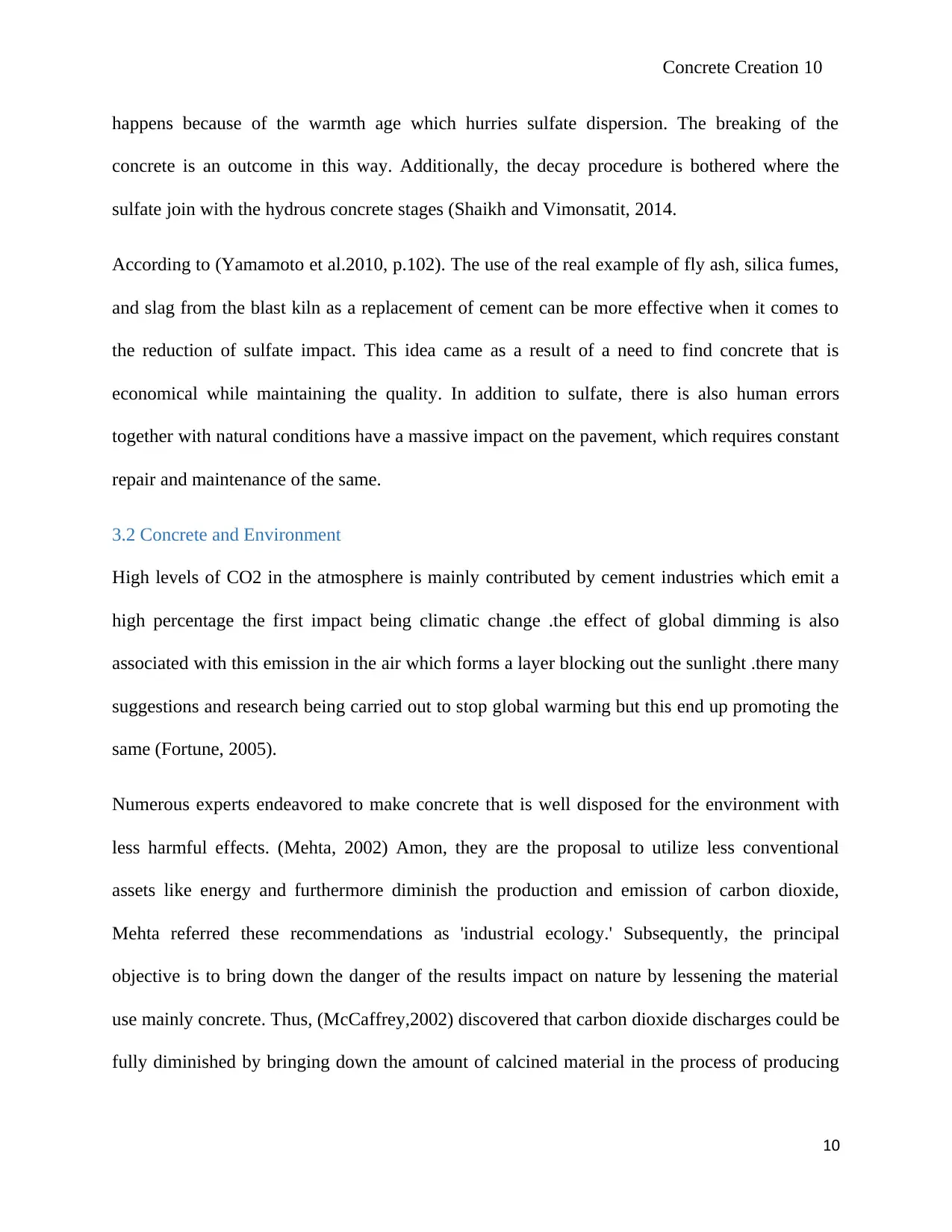
Concrete Creation 10
happens because of the warmth age which hurries sulfate dispersion. The breaking of the
concrete is an outcome in this way. Additionally, the decay procedure is bothered where the
sulfate join with the hydrous concrete stages (Shaikh and Vimonsatit, 2014.
According to (Yamamoto et al.2010, p.102). The use of the real example of fly ash, silica fumes,
and slag from the blast kiln as a replacement of cement can be more effective when it comes to
the reduction of sulfate impact. This idea came as a result of a need to find concrete that is
economical while maintaining the quality. In addition to sulfate, there is also human errors
together with natural conditions have a massive impact on the pavement, which requires constant
repair and maintenance of the same.
3.2 Concrete and Environment
High levels of CO2 in the atmosphere is mainly contributed by cement industries which emit a
high percentage the first impact being climatic change .the effect of global dimming is also
associated with this emission in the air which forms a layer blocking out the sunlight .there many
suggestions and research being carried out to stop global warming but this end up promoting the
same (Fortune, 2005).
Numerous experts endeavored to make concrete that is well disposed for the environment with
less harmful effects. (Mehta, 2002) Amon, they are the proposal to utilize less conventional
assets like energy and furthermore diminish the production and emission of carbon dioxide,
Mehta referred these recommendations as 'industrial ecology.' Subsequently, the principal
objective is to bring down the danger of the results impact on nature by lessening the material
use mainly concrete. Thus, (McCaffrey,2002) discovered that carbon dioxide discharges could be
fully diminished by bringing down the amount of calcined material in the process of producing
10
happens because of the warmth age which hurries sulfate dispersion. The breaking of the
concrete is an outcome in this way. Additionally, the decay procedure is bothered where the
sulfate join with the hydrous concrete stages (Shaikh and Vimonsatit, 2014.
According to (Yamamoto et al.2010, p.102). The use of the real example of fly ash, silica fumes,
and slag from the blast kiln as a replacement of cement can be more effective when it comes to
the reduction of sulfate impact. This idea came as a result of a need to find concrete that is
economical while maintaining the quality. In addition to sulfate, there is also human errors
together with natural conditions have a massive impact on the pavement, which requires constant
repair and maintenance of the same.
3.2 Concrete and Environment
High levels of CO2 in the atmosphere is mainly contributed by cement industries which emit a
high percentage the first impact being climatic change .the effect of global dimming is also
associated with this emission in the air which forms a layer blocking out the sunlight .there many
suggestions and research being carried out to stop global warming but this end up promoting the
same (Fortune, 2005).
Numerous experts endeavored to make concrete that is well disposed for the environment with
less harmful effects. (Mehta, 2002) Amon, they are the proposal to utilize less conventional
assets like energy and furthermore diminish the production and emission of carbon dioxide,
Mehta referred these recommendations as 'industrial ecology.' Subsequently, the principal
objective is to bring down the danger of the results impact on nature by lessening the material
use mainly concrete. Thus, (McCaffrey,2002) discovered that carbon dioxide discharges could be
fully diminished by bringing down the amount of calcined material in the process of producing
10
Paraphrase This Document
Need a fresh take? Get an instant paraphrase of this document with our AI Paraphraser
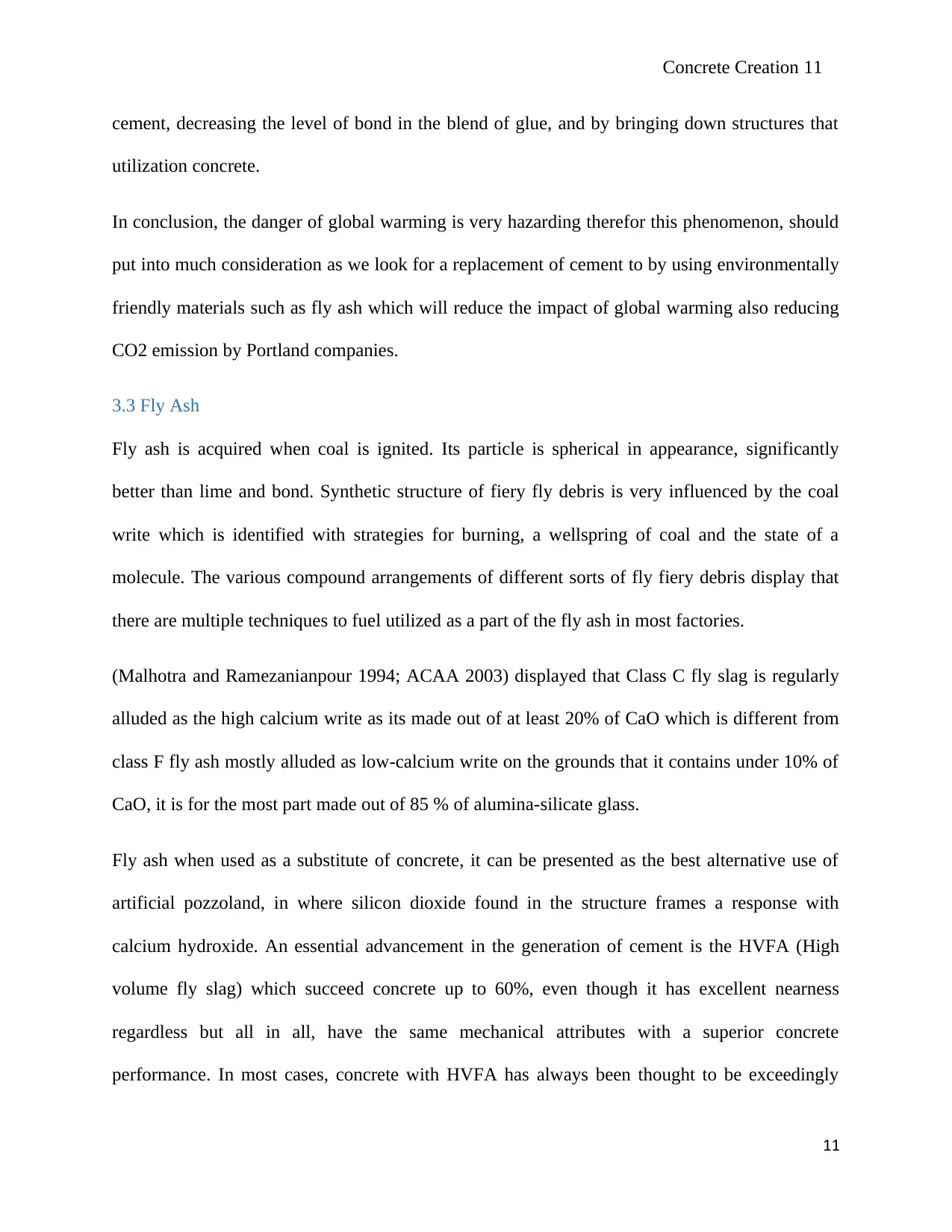
Concrete Creation 11
cement, decreasing the level of bond in the blend of glue, and by bringing down structures that
utilization concrete.
In conclusion, the danger of global warming is very hazarding therefor this phenomenon, should
put into much consideration as we look for a replacement of cement to by using environmentally
friendly materials such as fly ash which will reduce the impact of global warming also reducing
CO2 emission by Portland companies.
3.3 Fly Ash
Fly ash is acquired when coal is ignited. Its particle is spherical in appearance, significantly
better than lime and bond. Synthetic structure of fiery fly debris is very influenced by the coal
write which is identified with strategies for burning, a wellspring of coal and the state of a
molecule. The various compound arrangements of different sorts of fly fiery debris display that
there are multiple techniques to fuel utilized as a part of the fly ash in most factories.
(Malhotra and Ramezanianpour 1994; ACAA 2003) displayed that Class C fly slag is regularly
alluded as the high calcium write as its made out of at least 20% of CaO which is different from
class F fly ash mostly alluded as low-calcium write on the grounds that it contains under 10% of
CaO, it is for the most part made out of 85 % of alumina-silicate glass.
Fly ash when used as a substitute of concrete, it can be presented as the best alternative use of
artificial pozzoland, in where silicon dioxide found in the structure frames a response with
calcium hydroxide. An essential advancement in the generation of cement is the HVFA (High
volume fly slag) which succeed concrete up to 60%, even though it has excellent nearness
regardless but all in all, have the same mechanical attributes with a superior concrete
performance. In most cases, concrete with HVFA has always been thought to be exceedingly
11
cement, decreasing the level of bond in the blend of glue, and by bringing down structures that
utilization concrete.
In conclusion, the danger of global warming is very hazarding therefor this phenomenon, should
put into much consideration as we look for a replacement of cement to by using environmentally
friendly materials such as fly ash which will reduce the impact of global warming also reducing
CO2 emission by Portland companies.
3.3 Fly Ash
Fly ash is acquired when coal is ignited. Its particle is spherical in appearance, significantly
better than lime and bond. Synthetic structure of fiery fly debris is very influenced by the coal
write which is identified with strategies for burning, a wellspring of coal and the state of a
molecule. The various compound arrangements of different sorts of fly fiery debris display that
there are multiple techniques to fuel utilized as a part of the fly ash in most factories.
(Malhotra and Ramezanianpour 1994; ACAA 2003) displayed that Class C fly slag is regularly
alluded as the high calcium write as its made out of at least 20% of CaO which is different from
class F fly ash mostly alluded as low-calcium write on the grounds that it contains under 10% of
CaO, it is for the most part made out of 85 % of alumina-silicate glass.
Fly ash when used as a substitute of concrete, it can be presented as the best alternative use of
artificial pozzoland, in where silicon dioxide found in the structure frames a response with
calcium hydroxide. An essential advancement in the generation of cement is the HVFA (High
volume fly slag) which succeed concrete up to 60%, even though it has excellent nearness
regardless but all in all, have the same mechanical attributes with a superior concrete
performance. In most cases, concrete with HVFA has always been thought to be exceedingly
11
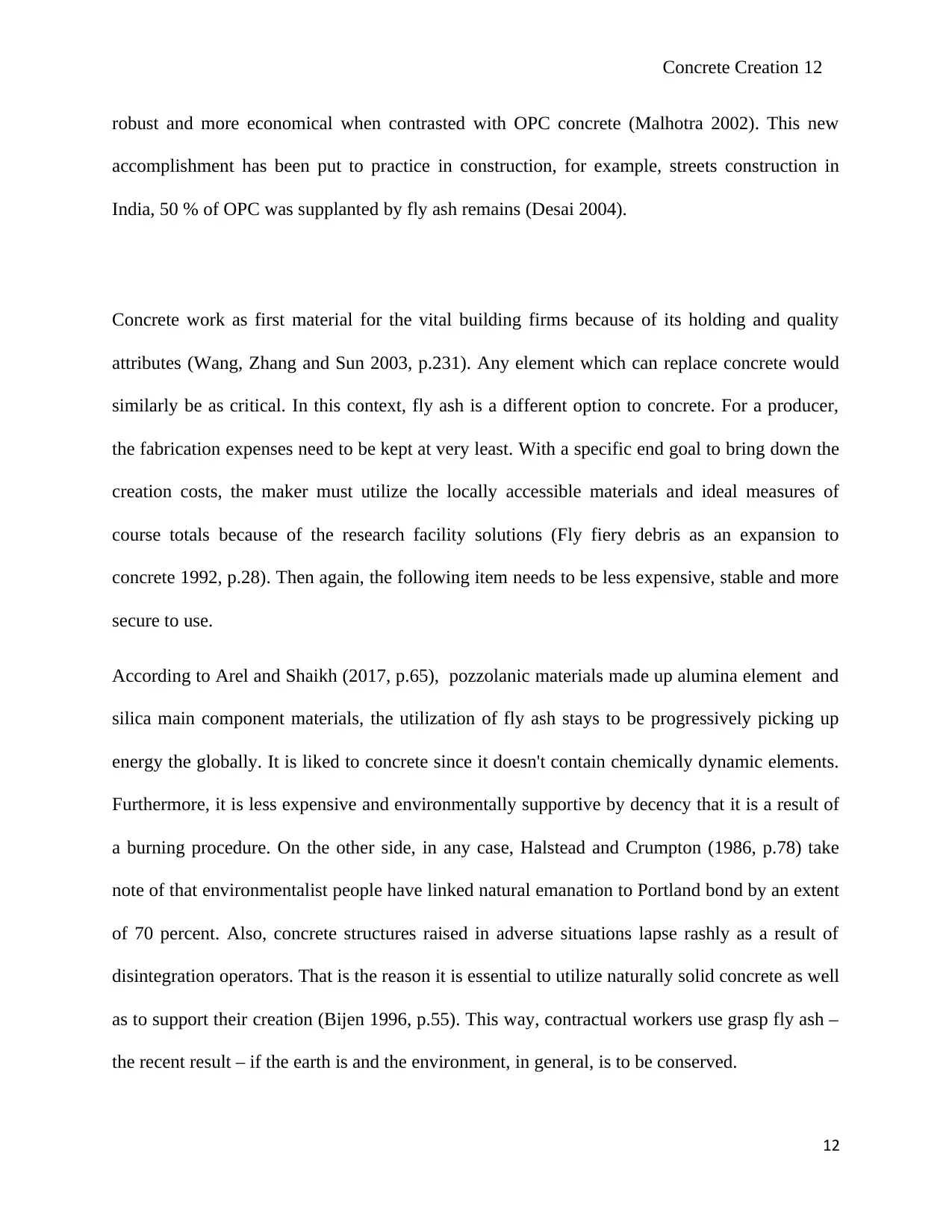
Concrete Creation 12
robust and more economical when contrasted with OPC concrete (Malhotra 2002). This new
accomplishment has been put to practice in construction, for example, streets construction in
India, 50 % of OPC was supplanted by fly ash remains (Desai 2004).
Concrete work as first material for the vital building firms because of its holding and quality
attributes (Wang, Zhang and Sun 2003, p.231). Any element which can replace concrete would
similarly be as critical. In this context, fly ash is a different option to concrete. For a producer,
the fabrication expenses need to be kept at very least. With a specific end goal to bring down the
creation costs, the maker must utilize the locally accessible materials and ideal measures of
course totals because of the research facility solutions (Fly fiery debris as an expansion to
concrete 1992, p.28). Then again, the following item needs to be less expensive, stable and more
secure to use.
According to Arel and Shaikh (2017, p.65), pozzolanic materials made up alumina element and
silica main component materials, the utilization of fly ash stays to be progressively picking up
energy the globally. It is liked to concrete since it doesn't contain chemically dynamic elements.
Furthermore, it is less expensive and environmentally supportive by decency that it is a result of
a burning procedure. On the other side, in any case, Halstead and Crumpton (1986, p.78) take
note of that environmentalist people have linked natural emanation to Portland bond by an extent
of 70 percent. Also, concrete structures raised in adverse situations lapse rashly as a result of
disintegration operators. That is the reason it is essential to utilize naturally solid concrete as well
as to support their creation (Bijen 1996, p.55). This way, contractual workers use grasp fly ash –
the recent result – if the earth is and the environment, in general, is to be conserved.
12
robust and more economical when contrasted with OPC concrete (Malhotra 2002). This new
accomplishment has been put to practice in construction, for example, streets construction in
India, 50 % of OPC was supplanted by fly ash remains (Desai 2004).
Concrete work as first material for the vital building firms because of its holding and quality
attributes (Wang, Zhang and Sun 2003, p.231). Any element which can replace concrete would
similarly be as critical. In this context, fly ash is a different option to concrete. For a producer,
the fabrication expenses need to be kept at very least. With a specific end goal to bring down the
creation costs, the maker must utilize the locally accessible materials and ideal measures of
course totals because of the research facility solutions (Fly fiery debris as an expansion to
concrete 1992, p.28). Then again, the following item needs to be less expensive, stable and more
secure to use.
According to Arel and Shaikh (2017, p.65), pozzolanic materials made up alumina element and
silica main component materials, the utilization of fly ash stays to be progressively picking up
energy the globally. It is liked to concrete since it doesn't contain chemically dynamic elements.
Furthermore, it is less expensive and environmentally supportive by decency that it is a result of
a burning procedure. On the other side, in any case, Halstead and Crumpton (1986, p.78) take
note of that environmentalist people have linked natural emanation to Portland bond by an extent
of 70 percent. Also, concrete structures raised in adverse situations lapse rashly as a result of
disintegration operators. That is the reason it is essential to utilize naturally solid concrete as well
as to support their creation (Bijen 1996, p.55). This way, contractual workers use grasp fly ash –
the recent result – if the earth is and the environment, in general, is to be conserved.
12
⊘ This is a preview!⊘
Do you want full access?
Subscribe today to unlock all pages.

Trusted by 1+ million students worldwide
1 out of 23
Your All-in-One AI-Powered Toolkit for Academic Success.
+13062052269
info@desklib.com
Available 24*7 on WhatsApp / Email
![[object Object]](/_next/static/media/star-bottom.7253800d.svg)
Unlock your academic potential
Copyright © 2020–2025 A2Z Services. All Rights Reserved. Developed and managed by ZUCOL.

